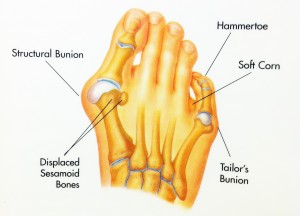 WHAT IS A HAMMERTOE?
WHAT IS A HAMMERTOE?
A hammertoe is an abnormal contracture of a joint in your toe due to a partial or complete dislocation of that joint or the joint that connects the toe to the rest of the foot. As the toe continues to contract it begins to rub against your shoe. This can cause your skin to react by thickening to protect the underlying bone, this thick skin is called a corn. But after chronic rubbing this corn can become too thick and also be a source of pain. Chronic rubbing of the contracted joint against the shoe can also cause a bursitis to develop demonstrated in a toe that is red, swollen and painful.
The contracture of the toe joint can occur at the joint closest to the toenail. This is called a mallet toe. It can also occur at the joint closest to where the toe connects to the foot. That is called a hammertoe. If a mallet toe occurs the corn will appear at the end of the toe due to the nature of the contracture. If a hammertoe occurs, the corn will appear on top of the contracture. Corns can also occur between toes if the bone becomes prominent between the toes and causes excessive rubbing.
Hammertoes can sometimes be asymptomatic or have no pain associated with them. Others may have pain due to tight shoes, muscles cramping due to the compensation of the deformity of the toe, or an arthritic pain might be present due to the chronic nature of the process.
HOW IS A HAMMERTOE DIAGNOSED?
A hammertoe is mainly diagnosed with a physical exam and a focused history. X-rays can also be used to identify boney prominences that are causing painful corns to form. Blood tests can also be done if there is suspicion of a systemic cause to the deformities, like rheumatoid arthritis.
WHY DO I HAVE A HAMMERTOE?
Shoe gear plays no role in the reason for hammertoe formation. The key players here are genes and the mechanics of your feet. Characteristics of our feet are hereditary and the mechanics, if abnormal, can further progress the problem. Individuals with flat feet or high arched feet create a situation where the tendons and muscles of the foot work differently and thus cause the toes to contract and rotate. A bunion deformity can also push the toes in an abnormal direction. The only role shoes play in this process is the aggravation of the boney prominences that result from the poor mechanics of the foot yielding painful corns, or a bursitis.
HOW CAN I TREAT THIS PROBLEM?
Shoes are a critical criteria in leading to relief in symptoms. Wearing well fitted, comfortable, roomy shoes will not irritate a contracted toe. High heeled shoes should be minimally worn. Walking shoes will help accommodate the contracted toes. Trimming corns on your own might be helpful but you are running the risk of cutting yourself and possibly creating a source of infection. Non medicated corn pads are recommended to allow relief from rubbing shoes.
WHAT WILL MY DOCTOR DO FOR THIS PROBLEM?
We will first perform a thorough history and physical exam and determine what type of contracture you have and whether it is from a systemic condition. Treatments may range from padding, shoe gear alterations, cortisone injections, periodic trimming of corns and calluses.
If conservative treatments fail surgical options are available and the type of surgery depends on the length of time the contracture has been present. If the contracture has occurred recently and is flexible the surgery is less involved. If the contracture in chronic and rigid then bone will have to be remodeled and a resorbable pin must be used in some cases to maintain the correction. This pin is not visible after the surgery and does not need to be removed in the future because your body will slowly degrade it. A patient can walk immediately after either of these procedures in a stiff soled shoe that we provide.
CAN I PREVENT IT FROM HAPPENING AGAIN?
After either conservative treatment or surgery, follow your doctor’s orders, which may include advice regarding proper footgear, minimal use of high heel shoes, accommodative padding, or an orthotic worn inside the shoe to balance and improve the function of your feet.

